deal [adorama.com]
$1699 + free s/h (price drops in cart)
Key Features- Motherboard developed in partnership with Onkyo for improved tonal clarity
- Updated control panel layout with modern OLED graphic display
- Chopin Walzer (1-19) lesson book
- Tone Control setting with 8 selectable tone presets
- Low Volume Balance function for improved touch consistency at reduce volume
- Modern cabinet design modelled after larger Concert Artist instruments
- Improved Shigeru Kawai grand piano sounds
- Enhanced 'Light' Touch Curve setting for young children
What's in the box:- CA49 88-Key Grand Feel Compact Digital Piano (Premium Rosewood)
- Stand (with Assembly Hardware)
- Matching Bench
- AC Power Adapter
- Kawai 5 Year Limited Warranty
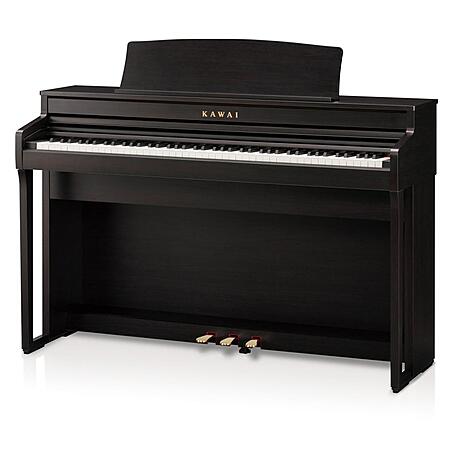
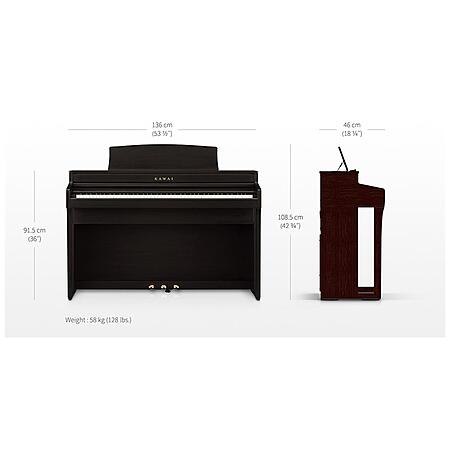
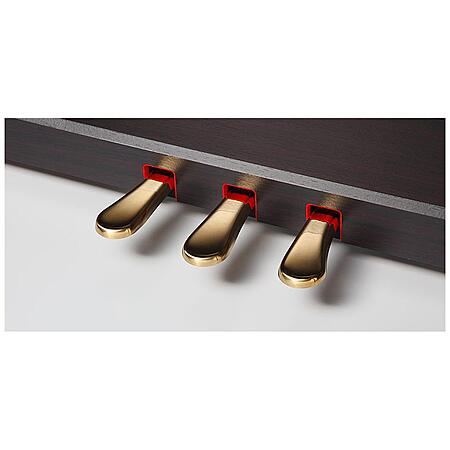
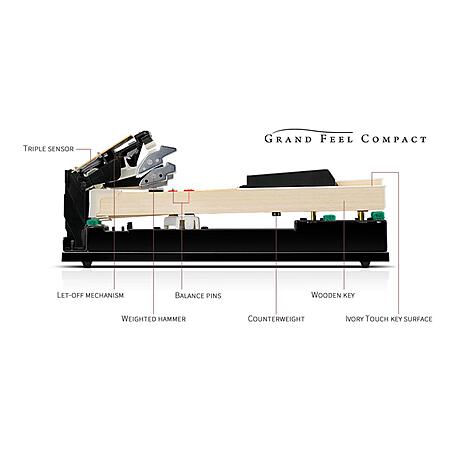


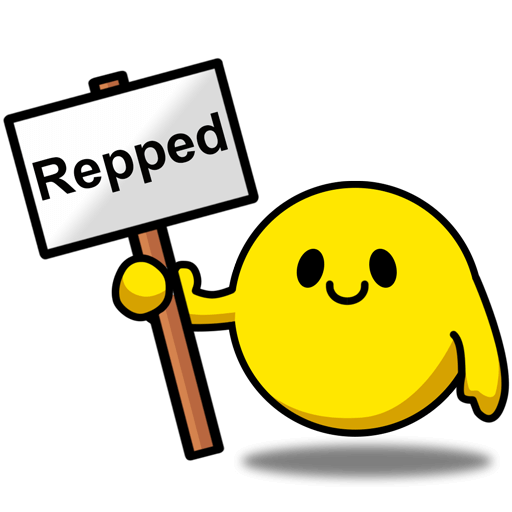

Leave a Comment
34 Comments
Sign up for a Slickdeals account to remove this ad.
It has extremely poor inter_key agreement, uneven response across the keybed.
https://forum.modartt.c
This is generally acceptable for piano playing, but it can be a problem if you're trying to get work done (recording), and (controlling) other instruments.
It has extremely poor inter_key agreement, uneven response across the keybed.
https://forum.modartt.c
This is generally acceptable for piano playing, but it can be a problem if you're trying to get work done (recording), and (controlling) other instruments.
I won't mention Roland's "hybrid wooden" keys. I think it's just a veneer.
Wooden keys serve a different audience.
The CA series is a piano for home playing, not for studio creative sessions where you would instead use something like a Roland RD-2000 designed with plastic key actions.
If anyone doesn't want wood, the Kawai CN series is the same thing but with plastic keys.
Plastic better if you play through a computer.
Solid wood feels like the real thing.
In fact, the Kawai wood series is pretty much identical to an acoustic key mechanism. Kawai makes their own highly expensive grand pianos as well.
If this drops down to $1300, I'm going to buy 10 of them.
Only their hybrid is an acoustic piano action which is all wood, but these are highly unreliable and has the SAME problem as all wooden actions, the Inconsistency and calibration drift occuring over time.
Wooden actions are unstable regardless of who makes them.
I would not recommend buying a wooden based action digital piano AT ANY PRICE. It is simply the wrong material to use in a digital input mechanism.
Only their hybrid is an acoustic piano action which is all wood, but these are highly unreliable and has the SAME problem as all wooden actions, the Inconsistency and calibration drift occuring over time.
Wooden actions are unstable regardless of who makes them.
I would not recommend buying a wooden based action digital piano AT ANY PRICE. It is simply the wrong material to use in a digital input mechanism.
People buying these home furniture style pianos aren't hooking them up to computers. They've never heard of DAWs and will never use them in a studio setting.
And people who have DAWs would never buy this style of piano.
Wood is UNRIVALED as authentic acoustic piano action because acoustic pianos use wood keys.
Again, most consumers buying these furniture / cabinet style home pianos are using them in lieu of acoustic pianos.
Show me 1 DAW setup that uses a furniture cabinet style piano and I'll show you 999,999 setups that do not. [google.com]
https://www.sweetwater.
Sign up for a Slickdeals account to remove this ad.
[/URL]
Not true, unrivaled according to whom , the advertising ?
Wood has NEVER been a good material for actions. that's why Kawai switched to originally abs styrene (which is fancy plastic), then eventually carbon fiber.
Yamaha made a similar switch in their actions as well.
They only kept the wooden parts for hammer shank because it has a warmer tone than carbon fiber shanks, but this can be balanced with scale design.
They kept wooden key sticks primarily for aesthetics, and how the last of the old farts who still play pianos can't get over wood.
WNG actions use full carbon fiber and does away with felt bushing for an extremely precise and stable action. The latest Mason and Hamlins also use Carbon fiber shanks when they switched to WNG actions.
funkmasterta, I can tell you're not a moron, but your awareness of piano technology is too superficial, you are spouting baseless remarks.
The WOODEN actions they put into digital pianos are no more than a GIMMICK, to upsell what's essentially 10 year old obsolete technology. The electronics in modern digital pianos are slower than a raspberry pie.
Look at kawai's ca99/ novus input system, it's slow as heck, the animation isn't even smooth, the software was outsourced to a random chinese company, and full of bugs. The UI is terrible.
https://www.sweetwater.
Go to the clarinova 785 page,
You can see it's a plastic core.
https://usa.yamaha.com/files/24-C...&imhei=458
There's A REASON, they don't use a full wooden stick, because wood = unstable. This makes it Particularly bad for digital pianos, because digital pianos run on a Deterministic system with hard table binds between input velocity and sound.
Go to the clarinova 785 page,
You can see it's a plastic core.
https://usa.yamaha.com/files/24-C...&imhei=458 [yamaha.com]
There's A REASON, they don't use a full wooden stick, because wood = unstable. This makes it Particularly bad for digital pianos, because digital pianos run on a Deterministic system with hard table binds between input velocity and sound.
People shopping for a piano should do their own research.
Read the opinions of others but these are simply OPINIONS.
If you love the feel of real wooden keys AND you plan to use this in your DAW setup, then go for it! There are plenty of folks who already have. Just go to YT and search for:
Kawai VPC1 Pianoteq [youtube.com]
People love to argue online over minutae and splitting hairs because it's the hobby of contemporary times.
Is it GOOD ENOUGH for beginners, sure, if you don't care that it has "reduced functionality", and you love paying lots of money for the privilege of reduced function, OK. But those are the facts.
Kawai's wooden action is the Juicero of piano actions. A lot of extra money spent to make an action worse and drifts badly over time..
People buying these home furniture style pianos aren't hooking them up to computers. They've never heard of DAWs and will never use them in a studio setting.
And people who have DAWs would never buy this style of piano.
Wood is UNRIVALED as authentic acoustic piano action because acoustic pianos use wood keys.
Again, most consumers buying these furniture / cabinet style home pianos are using them in lieu of acoustic pianos.
Show me 1 DAW setup that uses a furniture cabinet style piano and I'll show you 999,999 setups that ... [google.com]
Plastic will be okay for casuals, but for any serious playing, go for acoustic since most pianists who started from digital have trouble transitioning to acoustic. You might pick one up for free since most people are throwing them away.
https://www.nytimes.com/2012/07/3...-dump.html
https://www.seattletime
Our community has rated this post as helpful. If you agree, why not thank xtp
Plastic will be okay for casuals, but for any serious playing, go for acoustic since most pianists who started from digital have trouble transitioning to acoustic. You might pick one up for free since most people are throwing them away.
In general, Upright acoustic pianos have poor dynamism because the action is vertical. There is a HIGH Minimum threshold velocity for the hammers to work properly, this means uprights no matter how good/expensive have worse response when trying to produce Softer sounds. They've tried to improve this over the years with return spring rails and "Magnetic assisted shanks" etc, Hasn't really worked out, and the wooden action isn't stable enough for these bolt on rails to work properly over time, after a while, it just made the response of the action Murky.
Acoustic grand pianos have horizontal actions, this gives them an advantage in being able to produce softer notes with more regularity because Gravity naturally pulls the hammer in the right direction you want it to disengage. This also gives grands more overtones, people call it richness, as the hammer pulls away sooner.
HOWEVER, if you want the Absolute best Control over the dynamic range, Digital pianos far surpass Acoustic pianos. That is because digital's simplified actions are virtually always in perfect regulation, they are insensitive to humidity/ temperature, and they are completely uniform from 1 key to the next. The Soft and darker tones are also superior because they can be programed to any arbitrary volume/timbre.
In most of the ways we characterize Piano FUNCTION. Digital instruments are actually better and more consistent.
The difference really just comes down to Cultural Momentum. Acoustics pianos are extremely flawed and inconsistent. And we Associate that Analog-ness with realism. So it's much like vinyl, an inferior technology in most ways, but it refuses to go away because "People" have this emotional attachment to them.
Overall, Acoustic pianos have a high cost of ownership if you include proper action regulation service and tuning. If you skimp, yea it'll still make noises, but the control becomes really fricative, and you'll be fighting with the action, it's got thousands of parts that need lubrication. Proper care is ~$500 a year, improper, just 1 tuning a year is ~$150.
Acoustic piano is most likely going to disappear except for the very wealthy, what's disappearing faster than the piano themselves are the piano tuners and technicians, young people don't want to do this work. Piano work is delicate, you can easily break strings/ crack wooden parts, so, it's not practical for most people to DIY. Once these trades people diminish to a critical threshold, it becomes impossible to have proper acoustic pianos around.
This is exactly why I personally would prefer a digital over acoustic.
And I would get Kawai's NV series. It's the closest thing to acoustic playing (wooden keys + wooden sound board) with the advantages of digital (every note is in tune all the time).
Check out this lady who can identify the brand and model, and whether they are digital or acoustic... BLINDFOLDED!
https://www.youtube.com/watch?v=nol2FX5
Except the Kawai NV series has her stumped, she thought it was acoustic. The wooden soundboard restores the warmth and soul of the digitally produced sound.
Despite what XTP keep parroting, I personally love the organic warmth of wooden keys. Besides, unless you have a high quality audio interface and fantastic CPU, you will have to deal with latency with any vst.
And I would never spend the kind of money on a Kawai NV series and use it as part of a DAW setup. That'd be a waste of money. Just get a cheap plastic keyboard for a DAW setup. Get wooden keys if it's being used as a piano.
Sign up for a Slickdeals account to remove this ad.
This is exactly why I personally would prefer a digital over acoustic.
And I would get Kawai's NV series. It's the closest thing to acoustic playing (wooden keys + wooden sound board) with the advantages of digital (every note is in tune all the time).
I personally love the organic warmth of wooden keys.
And I would never spend the kind of money on a Kawai NV series and use it as part of a DAW setup. That'd be a waste of money. Just get a cheap plastic keyboard for a DAW setup. Get wooden keys if it's being used as a piano.
The consumer is programmed by advertising to believe "wood" is better. Wood is wood. in terms of function, it's worse.
The advertising would have you believe kawai's NV is the closest thing to acoustic, and "THAT'S A GOOD THING".
That's an outright lie. For one thing, the action is more unstable, so control-ability has regressed. The sound engine on the NV is the same engine as on the ca79/99, which uses an abysmal 256MB of total rom. It's junk tier. Even Free VSTs have larger/better samples. VSL have 200GB single pianos. The UI touch screen is jerky and not smooth. $10000 well spent. That just tells you how tech illiterate the typical piano consumer is. You get FREE cellphones today with Smoother experience than Kawai's touchscreen.
It is obsolete junk masquerading as a high class product.
Leave a Comment